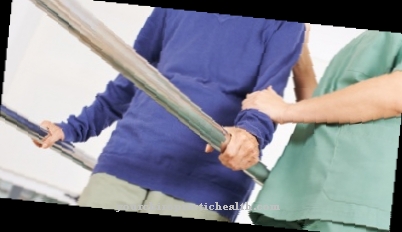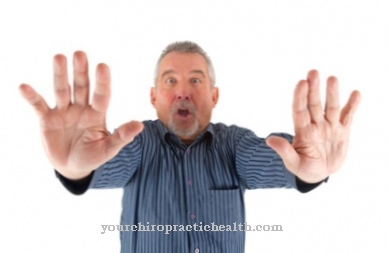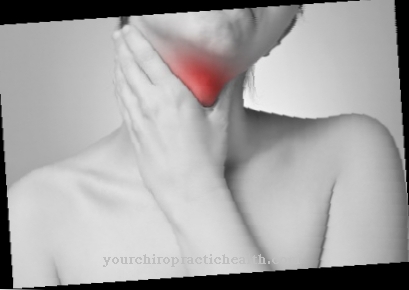Back pain are actually not an independent illness but mostly a symptom of an illness. Back pain is widespread and is therefore a widespread disease. They are the second most common complaint to general practitioners.
What is back pain?

Back pain is, as the name itself expresses, pain in or on the back, which is often caused by signs of wear and tear. Back pain can be divided into radicular and pseudoradicular pain. With radicular back pain, a nerve is usually irritated. This occurs, for example, with a herniated disc.
Back pain caused by a defect in the spine or joints is called pseudoradicular back pain. Other forms of back pain are: lower back pain, lumbago and chronic back pain.
causes
The causes of back pain are many. Often the causes are not found at all or several causes are responsible for the back pain.
Nevertheless, the causes can be classified into two broad categories. On the one hand there are physical or organic reasons, which also include obesity, tension, incorrect strain and poor posture.
On the other hand, psychosomatic illnesses are also responsible for back pain.
A list of diseases that have back pain as a symptom can be found below.
You can find your medication here
➔ Medicines for back painDiseases with this symptom
- Obesity
- Irritable bowel syndrome
- disc prolapse
- Spinal stenosis
- Kidney stones
- Flat back
- osteoporosis
- sciatica
- Facet syndrome
- ankylosing spondylitis
- Pelvic inflammation
- Angina pectoris
- Vertebral joint arthrosis
- Vertebral blockage
- ISG syndrome
- Shingles
- Prostatitis
- pleurisy
Diagnosis & course
The diagnosis of back pain is simple: one or more sections on the back of the body hurt more or less. Muscles, tendons or nerves are affected.
The doctor will have the symptoms described, examine the back by hand, try various positions - how well can the patient bend over, turn his head, pull his arms back or tilt the trunk sideways - and if in doubt, X-rays or even magnetic resonance imaging arrange.
If nerves are affected, their functionality is tested by neurological examinations. The therapy ranges from massages to physiotherapy and sports prescriptions to operations, for example when vertebrae or intervertebral discs are affected.
Complications
The complications of back pain, as well as the further course of this symptom, depends heavily on the person concerned and also depends on the person's physical activity. In most cases, back pain occurs at an advanced age and is the normal aging process. It does not necessarily have to lead to complications.
If the back pain is not particularly severe or only occurs after a long day of sitting, it can also be compensated for by exercising. So they are also a sign that a person sits too long a day and does not move enough. In some cases, massage or physical therapy is also ordered for back pain.
The back and shoulders can be relaxed, which also eliminates the back pain. Complications arise when the back pain causes sprains that lead to severe pain. These pains are not temporary, but permanent and no longer allow the person affected to have a normal everyday life.
This means that certain jobs are no longer possible, which in many cases leads to the loss of the job. Back pain should always be treated so that it doesn't come to that. If physical activity is unsuccessful, the doctor may recommend therapy to counteract the problem.
When should you go to the doctor?
Since back pain is an indication of long-term unhealthy posture, it is not wrong to have it examined by a doctor, even if it is mild. Because the sooner such a posture problem is recognized and treated, the less likely it is to have serious back problems such as slipped discs or pinched nerves. However, most people wait to see a doctor until the back pain gets worse and affects their everyday life.
This not only increases the duration of the necessary treatment, but of course also weakens the back unnecessarily. At best, the doctor is consulted at the latest when recurring or even regular back pain occurs - regardless of how painful it is. A doctor's appointment is also and especially necessary if the back pain is accompanied by symptoms such as dizziness and lightheadedness, as this indicates a pinched nerve. It can take a long time for these symptoms to improve on their own, as the nerve has to be "pinched out" again.
A doctor, on the other hand, needs a few seconds to straighten the back with a short massage and free the nerve. If you have already had severe back problems such as herniated discs and now back pain recurs after a period of symptom relief, you should not wait to see a doctor regardless of the frequency and severity of the pain.
Doctors & therapists in your area
Treatment & Therapy
Back pain should always be examined by a doctor (orthopedic surgeon), even if it is not necessarily due to organic causes. Incorrect strain, bad posture and excess weight can also put a lot of strain on the body in the long term and lead to illnesses.
As with all complaints, the doctor will first talk to the person concerned in order to determine the general conditions for a later diagnosis. It is important that you describe all previous illnesses to the doctor. Particularly in older patients, bone loss (osteoporosis) and joint wear (arthrosis) play an elementary role in diagnostics. The doctor will also want to clarify potential psychosomatic causes (e.g. depression), which can then be cured with another series of treatments (e.g. psychotheraphy).
It is also important to clarify whether bad posture or stress caused the back pain.
After that, the doctor will do a physical exam. He will usually rely on x-rays, computed tomography (CT) or magnetic resonance imaging (MRI).
Special abnormalities, such as a curvature of the spine, poor posture of the shoulder and excessive strain on the body can be quickly identified. Further physical exams can be performed through an analysis of reflexes, muscle strength, and flexibility. The doctor will pay particular attention to the joints.
Damage to the nerves is rarely responsible for back pain. However, further treatment should then be carried out by a neurologist.
Once the causes of the back pain have been found, the right therapy begins. Above all, massages, acupuncture, heat treatments, autogenic training and progressive muscle relaxation have proven themselves. Medication or surgery should only be resorted to in an emergency if the former treatments do not bring the desired results. But only after a detailed medical consultation.
Outlook & forecast
Back pain occurs in a large number of people and can be treated relatively well. With early treatment, long-term effects and other pain can be prevented so that the back pain does not lead to further complications or restrictions. In most cases, treatment takes the form of therapy or massage.
Back pain can severely restrict the everyday life of those affected. This means that certain activities are no longer possible or lead to very great pain. Back pain is often caused by an incorrect sitting posture and no sporting activity. Changing your sitting posture and doing a sport can therefore prevent back pain.
If the back pain only occurs occasionally and does not restrict everyday life, there is no need to see a doctor. However, a doctor should be asked for advice if the back pain is permanent and movement is no longer possible. Surgical interventions are usually not carried out, and drugs are rarely used for treatment.
You can find your medication here
➔ Medicines for back painprevention
Home remedies ↵ for back pain
pain
Back pain that is not caused by organic diseases can be prevented well. Above all, a healthy diet, lots of physical activity through sport and relaxation techniques are the most sustainable ways of preventing back pain. Sports that build muscles that take pressure off the joints are best. This includes swimming and light weight training. A medical back school is also beneficial.
Continue to ensure a stress-free and relaxed life. Refrain from alcohol and smoking. If you have to sit a lot in everyday life, try to sit on suitable, orthopedic chairs. Find out more from your orthopedic surgeon.
You can do that yourself
If you have back pain, it is always helpful to take up physical activity. This does not have to fully exhaust the person concerned and must not put too much strain on the back. Activities such as jogging or cycling should therefore be chosen. Weight lifting and bench press, on the other hand, should be avoided. As a rule, all activities that put a lot of strain on the back should be avoided. Above all, this includes lifting and moving heavy objects. When lifting, the patient should kneel down so that the back is relieved. Sports therapy that specifically pays attention to muscular deficits and focuses on targeted muscle building and strengthening can have a beneficial effect on the relief of back pain.
A healthy posture also helps against back pain. The back should be straight and not bent. Especially with an office job, it is helpful to get up and move around at least twice an hour. Sufficient fluid intake, water is recommended, should always be ensured.
If the pain is more severe, massages can help; these can also be carried out by your own partner. The treatment is accelerated by heat. Here the patient can, for example, take a warming bath with essential oils or warm up the affected area on the back with a warming pillow. However, very severe back pain should be treated by a doctor so that there are no consequential damages.





.jpg)


















.jpg)



